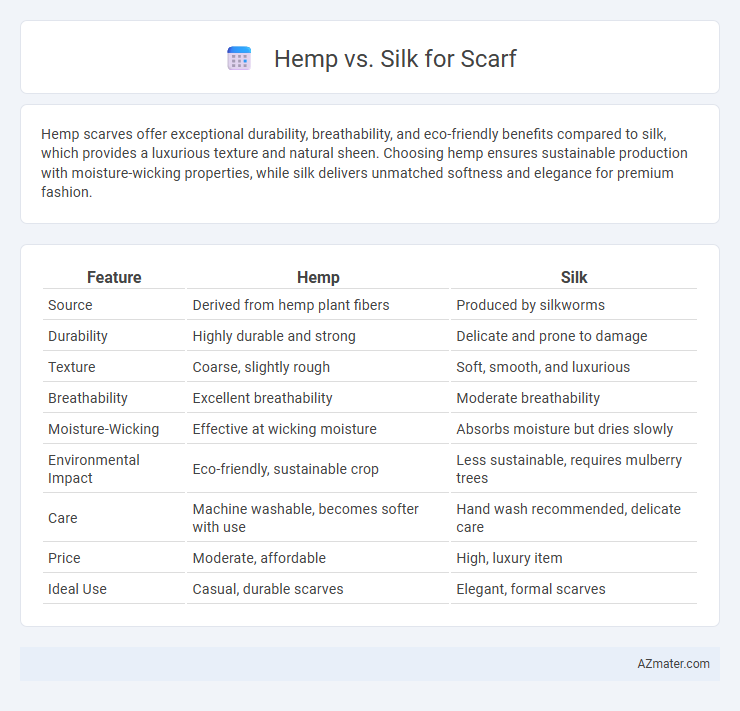Hemp scarves offer exceptional durability, breathability, and eco-friendly benefits compared to silk, which provides a luxurious texture and natural sheen. Choosing hemp ensures sustainable production with moisture-wicking properties, while silk delivers unmatched softness and elegance for premium fashion.
Table of Comparison
| Feature | Hemp | Silk |
|---|---|---|
| Source | Derived from hemp plant fibers | Produced by silkworms |
| Durability | Highly durable and strong | Delicate and prone to damage |
| Texture | Coarse, slightly rough | Soft, smooth, and luxurious |
| Breathability | Excellent breathability | Moderate breathability |
| Moisture-Wicking | Effective at wicking moisture | Absorbs moisture but dries slowly |
| Environmental Impact | Eco-friendly, sustainable crop | Less sustainable, requires mulberry trees |
| Care | Machine washable, becomes softer with use | Hand wash recommended, delicate care |
| Price | Moderate, affordable | High, luxury item |
| Ideal Use | Casual, durable scarves | Elegant, formal scarves |
Introduction: Hemp vs Silk Scarves
Hemp scarves offer durability and eco-friendly benefits, made from natural fibers known for breathability and resistance to wear. Silk scarves provide a luxurious feel with smooth texture, lightweight softness, and natural sheen, often favored for elegance and comfort. Choosing between hemp and silk scarves depends on preferences for sustainability, texture, and maintenance.
Environmental Impact: Hemp vs Silk
Hemp cultivation requires significantly less water and pesticides compared to silk production, making it a more sustainable option for scarves. The production of silk involves boiling silkworms, which raises ethical and environmental concerns, while hemp is a renewable plant requiring minimal resources. Hemp fibers are biodegradable and have a lower carbon footprint, contributing to a reduced environmental impact relative to silk.
Texture and Feel: Comfort Comparison
Hemp scarves feature a coarse yet increasingly softer texture as the fibers are refined, offering a breathable, durable feel ideal for casual wear. Silk scarves provide an incredibly smooth, lightweight, and luxurious sensation against the skin, renowned for their natural sheen and softness. The comfort of hemp leans toward a rustic, eco-friendly appeal with greater moisture-wicking properties, while silk excels in delivering gentle elegance and a cool, silky touch perfect for sensitive skin.
Durability and Longevity
Hemp fibers exhibit exceptional durability and resistance to wear, making hemp scarves highly resilient to daily use and less prone to tearing or pilling compared to silk. Silk scarves, while luxurious and smooth, tend to be more delicate, requiring careful handling and maintenance to preserve their longevity. Choosing hemp for scarves guarantees a longer lifespan due to its natural strength and resistance to environmental damage, ultimately offering a more sustainable option.
Moisture-Wicking and Breathability
Hemp fibers excel in moisture-wicking and breathability, offering excellent absorption and quick drying properties that keep the skin dry and comfortable. Silk, while smooth and luxurious, provides moderate breathability but tends to retain moisture longer, which can lead to discomfort in humid conditions. Choosing hemp for scarves ensures superior ventilation and moisture management, ideal for active wear or warm climates.
Allergenicity and Skin Sensitivity
Hemp scarves exhibit low allergenicity due to their natural, hypoallergenic fibers, making them suitable for sensitive skin and reducing irritation risks. Silk scarves, while smooth and gentle, may trigger allergic reactions in individuals sensitive to sericin proteins or processed chemicals. Choosing hemp or silk depends on personal skin sensitivity, with hemp providing a more breathable, antimicrobial option and silk offering a luxurious feel.
Dye Affinity and Color Vibrancy
Hemp fibers exhibit strong dye affinity due to their porous structure, allowing deep pigment penetration that results in rich, long-lasting color vibrancy ideal for scarves. Silk, with its protein-based composition, absorbs dyes vividly, producing brilliant, luminous hues that enhance scarf aesthetics with a natural sheen. Both materials maintain excellent color retention, but silk's smooth surface intensifies color brilliance, while hemp offers a more matte, rustic finish that appeals to natural dye techniques.
Maintenance and Care Requirements
Hemp scarves require minimal maintenance due to their natural durability and resistance to mold and UV damage, often only needing gentle hand washing with mild detergent and air drying to preserve fiber strength. Silk scarves demand more delicate care, including hand washing in cold water with specialized silk detergent or dry cleaning to maintain their smooth texture and vibrant colors, along with avoiding direct sunlight to prevent fading. Proper storage for both involves keeping scarves away from moisture and harsh light, but silk especially benefits from being stored flat or rolled to prevent creasing.
Ethical and Sustainable Production
Hemp scarves offer a highly sustainable and ethical choice due to hemp's rapid growth cycle, minimal water use, and natural pest resistance, reducing the need for harmful pesticides. Silk production often involves resource-intensive mulberry cultivation and raises ethical concerns related to silkworm harvesting, though wild silk variants present more eco-friendly options. Choosing hemp supports environmentally responsible farming practices and promotes cruelty-free fashion, aligning with sustainable wardrobe values.
Price Point and Value for Money
Hemp scarves generally offer a lower price point due to the sustainable and fast-growing nature of hemp plants, making them an affordable yet eco-friendly option. Silk scarves tend to be more expensive because of the labor-intensive production process and luxurious texture, which contributes to their perceived high value. When considering value for money, hemp provides durability and breathability at a budget-friendly cost, while silk delivers elegance and softness that justifies its premium price.

Infographic: Hemp vs Silk for Scarf
 azmater.com
azmater.com